In my last blog I looked at how old problems often persist because we approach them the same way we always have.
I believe the key to unlocking these stubborn challenges lies in two often-overlooked traits: creativity and curiosity. When combined, they form a dynamic duo that can change the way any business approaches problem solving.
Take, for example, the case of a metropolitan water utility I worked for. It was facing a surge in wastewater (sewer) blockages due to non-biodegradable wet wipes being flushed. This issue not only caused operational, health, and environmental challenges but also impacted customers directly through overflows on to their property. Yes, it’s as bad as you’re thinking.
Despite previous customer communications (letters, leaflets etc), customer behaviour hadn’t changed. It was an opportunity to rethink the approach.
The first step was curiosity — asking “why?” to deeply understand the problem. This led to a three-stage qualitative and quantitative research project, which uncovered surprising insights. It was young males, not new mothers as initially assumed, who were the primary users and flushers of wet wipes.
These findings fundamentally challenged the team’s assumptions and provided clarity on the real drivers behind the issue. Armed with these insights, we could tailor a campaign to resonate with the right audience.
Creativity came next, with impactful messaging and innovative tactics. Visuals like “fatbergs” made the problem visceral and impossible to ignore, while playful tie-ins, such as a dinosaur-themed message coinciding with the release of a Jurassic Park movie, captured attention.
Strategic messaging placement — on social media, bus stops, and even shopping centre and hospitality venue bathroom doors — ensured the message reached the audience where the behaviour occurred. Collaborating with other water utilities (who also experienced the same problem) and stakeholders amplified the campaign’s reach and longevity.
Additionally, industry engagement played a crucial role. The utility worked with manufacturers to advocate for better product design and packaging, making it easier for consumers to dispose of wet wipes properly. This collaboration ultimately led to the development of an Australian Standard for non-flushable products.
The results were transformative: a significant reduction in flushed wipes and other bathroom items, heightened customer awareness, and worldwide media coverage. Customer research post-campaign showed a 50% decrease in people who thought flushing wipes was acceptable. The campaign also won industry awards and strengthened the organisation’s reputation as a leader within its industry and of putting its customers first.
For me, this case demonstrates the immense value of curiosity and creativity in solving entrenched problems.
So, what’s your business challenge? How could a curious mindset and creative solutions unlock new opportunities? Let’s talk!
Photo by Naira Babayan on Unsplash


